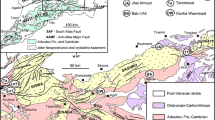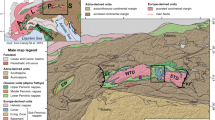Abstract
The Ethiopian Rift Valley, which cuts the uplifted Ethio-Somalian Plateau, is one of the most important structures of East Africa, and nevertheless it is still largely unknown.
A preliminary 1/500,000 geological map as well as volcanological and petrological descriptions of an important part of this structure are presented.
This part of the Ethiopian Rift Valley is marked by a set of NNE-SSW normal faults. « En échelon » arrangements, rift-in-rift structures, asymmetry and open tensional fissures are its most important tectonic features. The region has been affected by volcanism since Eocene in the neighbouring Plateaux and since probably Pliocene within the Rift, with fissure eruptions and growth of individual volcanoes. Non-volcanic rocks consist exclusively of lacustrine sediments. Magmatic products on both Plateaux are represented mainly by huge piles of basaltic lava flows, whilst within the Rift most of the volcanics are widespread ignimbritic units.
The presence of such large amount of ignimbrites can easily explain some important volcano-tectonic collapses which produced large regional calderas. Although still insufficient, the available petrological data suggest that the Plateau basalts have more alkalic character than those within the Rift, which show a transitional nature between alkali basalts and tholeiites. Intermediate rocks seem to be scarce and most of the silicic products are monotonously represented by peralkaline rhyolites (mostly pantellerites).
The genesis of the peralkaline silicic rocks might be related to the presence, along the Rift axis, of a huge basic igneous body recently discovered by a geophysical investigation. This could explain the presence of large volume of these rocks within the Rift, although the apparent scarcity of intermediate rocks remains unexplained.
Résumé
La Rift Valley d’Ethiopie qui recoupe le Plateau Ethio-Somalien est une des plus importantes structures de l’Afrique orientale, et néanmoins encore très peu connue.
Ce texte présente une carte géologique préliminaire au 1/500.000 ainsi qu’une description volcanologique et pétrologique d’un secteur important de cette structure.
La partie étudiée de la Rift Valley d’Ethiopie présente les caractéristiques suivantes: système le failles normales orientées NNE-SSW, style « en échelon », structures « rift in rift », asymétrie du graben et présence de nombreuses fissures de tension ouvertes. Toute la région a été affectée par le volcanisme depuis l’Eocène dans les Plateaux environnants et probablement depuis le Pliocène dans le Rift, avec éruptions fissurales et édification de volcans individuels. Les roches non volcaniques sont représentées uniquement par des dépôts lacustres. Les produits magmatiques des deux Plateaux sont, pour la plupart, représentés par des centaines de coulées de lave basaltique empilées, tandis que dans le Rift, la majeure partie des produits volcaniques est constituée par des ignimbrites. Les éruptions d’ignimbrites sont responsables de la formation de grandes caldéras régionales. Les données pétrologiques actuellement disponibles, bien qu’encore insuffisantes, suggèrent que les basaltes de Plateau ont un caractère plus alcalin que ceux du Rift qui montrent une nature transitionnelle entre les basaltes alcalins et les tholéiites. Les roches intermédiaires semblent être rares et la majorité des produits acides est représentée uniquement par des rhyolites peralcalines (pantellérites pour la plupart).
Récentes données géophysiques indiquent la présence, le long de l’axe du Rift, d’une importante intrusion de magma basique qui pourrait ainsi expliquer la grande quantité de roches peralcalines que l’on trouve dans le Rift, bien que l’apparente rareté des roches intermédiaires reste inexpliquée.
Similar content being viewed by others
References
Abbate, E., Facibeni, P., Gregnanin, A., Merla, G. andSagri, M., 1969,Basalt flows and related sandstones in the Socota area (Northern Ethiopia). Boll. Soc. Geol. It.,88, p. 499–516.
Bailey, D. K., 1964,Crustal Warping — A possible tectonic control of alkaline magmatism. Journ. of Geoph. Res.,69, n. 6.
Baker, B. H. andWohlenberg, J., 1971,Structure and evolution of the Kenya rift valley. Nature,229, p. 538–42.
-----,Mohr, P. A. andWilliams, L. A. J., 1972,Geology of the Eastern Rift System of Africa. Geol. Soc. of America, Special paper, 136.
Barberi, F., Borsi, S., Ferrara, G. Marinelli, G. andVaret, J., 1970,Relations between tectonics and magmatology in the Northern Danakil Depression (Ethiopia). Phil. Trans Roy. Soc. Long., A.267, p. 293–311.
Cole, J. W., 1969,Gariboldi volcanic complex, Ethiopia. Bull. Volcan.,33, p. 566–578.
Coombs, D. S., 1963,Trends and affinities of basaltic magmas and pyroxenes as illustrated on the diopside-olivine-silica diagram. Miner. Soc. Amer., (Spec. Pap. I), p. 227–250.
Dainelli, G., 1943,Geologia dell’Africa Orientale. 3, R. Accad. d’Italia, Roma.
Di Paola, G. M., 1972,Geology of the Corbetti Caldera Area (Main Ethiopian Rift Valley). Bull. Volcan.,35-2, p. 497–506.
Franzini, M. andLeoni, L., 1972,A full matrix correction in x-ray fluorescence analysis. Atti della Soc. Tos. Sc. Nat. Sez. A (In press).
Gass, I. G. andMallick, D. I. J., 1968,Jebel Khariz: an Upper Miocene strato-volcano of comenditic affinity on the South Arabian Coast. Bull. Volcan.XXXII-1, p. 33–88.
Gibson, I. L., 1967,Preliminary account of the volcanic geology of Fant-Ale (Shoa). Bull. Geophys. Obs. Addis Ababa, n. 10, p. 59–67.
————— andTazieff, H., 1970,The structure of Afar and the Northern part of the Ethiopian Rift. Phil. Trans. Roy. Soc. Lond. A. 267, p. 331–338.
King, B. C., 1970,Vulcanicity and rift tectonics in East Africa. InAfrican Magmatism and tectonics. p. 263–283, Oliver and Boyd, Edinburgh.
----- andSutherland, D. S., 1960,Alkaline rocks of eastern and Southern Africa. Sci. Progr.,48, (190, 191 and 192).
Kuno, H., 1968,Differentiation of Basalt Magma. In:Basalts: the Poldervaart Treatise of Rocks of Basaltic Composition. Vol. 2, New York-London-Sidney, John Wiley and Sons, N. Y.
Le Bas, M. J. andMohr, P. A., 1970,Tholeiite from the Simien alkali basalt centre, Ethiopia. Geol. Mag.,107, p. 523–29.
Macdonald, G. A., andKatsura, T., 1964,Chemical Composition of Hawaiian Lavas. J. Petrol.,5, p. 82–133.
Macdonald, R. andBailey, D. K., 1972,The chemistry of the peralkaline oversaturated obsidians. U. S. Geol. Surv. Profess. Paper 440 - N Part 1 (in press).
Miller, J. A. andMohr, P. A., 1966,Age of the Wachacha trachyte-Carbonatite volcanic centre. Bull. Geophys. Obs. Addis Ababa,9, p. 1–5.
Mohr, P. A., 1962,The Ethiopian Rift System. Bull. Geophys. Obs. Addis Ababa, n. 5, p. 33–62.
-----, 1967,The Ethiopian Rift System. Bull. Geophys. Obs. Addis Ababa, n. 11, p. 1–65.
Mohr, P. A., 1968,Transcurrent faulting in the Ethiopian Rift System. Nature,218, p. 938–40.
-----, 1970,Catalog of chemical analyses of rocks from the intersection of the African, Gulf of Aden and Red Sea rift systems. Smithsonian Contr. Earth Sci.,2, 269 pp.
----- andGouin, P., 1967,Gravity traverses in Ethiopia. Bull. Geophys. Obs. Addis Ababa, n. 10, p. 15–52.
Nesbitt, R. W. andHamilton, D. L., 1970,Crystallization of an alkali olivine basalt under controlled PO 2,PH 2 O conditions. Phys. Earth. Planet. Interiors,3, p. 309–315.
Rex, D. C., Gibson, I. L. andDakin, F., 1971,Age of the Ethiopian flood basalt succession. Nature Let. n. 880.
Ross, C. S. andSmith, R. L., 1961,Ash-flow tuffs: their origin, geologic relation and identification. Geol. Survey Perg. Paper 366.
Tazieff, H., 1968,Sur le mécanisme des éruptions basaltiques à faibles profondeurs et la genèse d’hyaloclastites associées. Geol. Rds.,57, p. 955–66.
Theilhard de Chardin, P. etLamare, P., 1930,Le Canon de l’Aouache et le volcan Fantale. Mem. Soc. Geol. de Fr., p. 283.
Yoder, H. S. andTilley, C. E., 1962,Origin of basalt magmas: an experimental study of natural and synthetic rock systems. J. Petrol.,3, p. 342–532.
Author information
Authors and Affiliations
Rights and permissions
About this article
Cite this article
Di Paola, G.M. The Ethiopian Rift Valley (between 7° 00′ and 8° 40′ lat. north). Bull Volcanol 36, 517–560 (1972). https://doi.org/10.1007/BF02599823
Received:
Issue Date:
DOI: https://doi.org/10.1007/BF02599823




